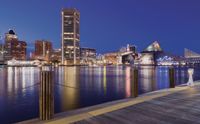IFPAC 2010
Spectroscopy previews the upcoming IFPAC Annual Meeting, which will be held in Baltimore, Maryland, once again, from January 31–February 2.
Baltimore has always made a convenient setting for conferences and symposia, with its central location on the eastern seaboard bringing in attendees from Boston, New York, and Philadelphia to the north, and Washington, Charlotte, and all points south as well. Perhaps this is why the IFPAC Meeting seems to have found a home here, as it has been held in the Inner Harbor for several years running now.

In addition to the location and numerous tourist venues for conferees to attend, the meeting itself promises to offer spectroscopists from all disciplines and application areas the unique opportunity to network and interact with colleagues for four days, and a number of new sessions and workshops have been added for 2010. The conference will cover critical and influential topics bringing academia, industry, and government together to share up-to-date knowledge and solutions.

The intensive three-day technical program will feature a high-profile plenary covering challenges and sustainability impacting industry and business today, and will be followed by forward-looking tracks with over 20 sessions covering the latest trends and technology on innovative research and progress. Some of the highlights of the program are:
- The Process Analysis/Spectroscopy track is back with new cutting edge information.
- Particle Characterization/Analysis-Ultrasound Spectroscopy
- Spectroscopy and Gas Chromatography (GC) Techniques
- Presentations on innovative research and progress in areas such as advanced instrumental concepts for process analysis, analyzer integration, manufacturing, and new sensor technology, better measurements in the control scheme, control strategies, and data management.
- New Sessions on Analyzer Integration/Shelter Safety/Process Safety/Area Monitoring/Safety Integrity
- Expert speakers, ground-breaking case studies, group discussions, and networking
- Receptions
- A comprehensive exhibition of PAT equipment and services
- Special workshops/training opportunities and an expanded poster session
Session Highlights
As usual, the IFPAC technical program promises to bring attendees all of the latest developments and cutting-edge technology in the field of materials analysis. Highlights of theis year's program are as follows.
Tuesday, February 2, 2010
Tuesday AM
Plenary Session
"A Stimulus for Product Quality and Lifecycles...Facing Today's Challenges"
Chairs: Theodora Kourti, George Vickers, and Vincent L. Vilker
Tuesday PM
- "QbD - I - New Directions and Modeling"
- "Bio-Processing (Industrial)"
- "Advanced Instrumental Concepts for Process Analysis"
- "Process Analysis/Spectroscopy - I"
- "Process Raman Symposium"
- "Chemometrics and Process Analytics - I"
Evening session on QbD: This evening session will provide the opportunity for an extensive discussion on issues related to QbD.
Wednesday, February 3, 2010
Wednesday AM
- "QbD - II - PAT"
- "Food Safety - Microbiological Contaminants"
- "NeSSI-I"
- "Advanced Separations- I (MS/HPLC/Components/GC)"
- "Imaging: Data Analysis and Emerging Techniques"
- "Chemometrics and Process Analytics - II"
Wednesday PM
- "QbD - III - Applications"
- "Food Safety - Chemical Contaminants"
- "NeSSI-II"
- "Advanced Separations - II (Smart & microGC)"
- "Imaging for Quality & Process Understanding"
- "Life Cycle Management of Analyzer and Method Reliability"
- Poster Session
- "Special Session I: PAT Applied for Biologics Manufacturing"
Evening session on NeSSI
Thursday, February 4, 2010
Thursday AM
- "Continuous Processes"
- "Food Applications - PAT"
- "Process Understanding & Control"
- "Pharma Waters and Real-Time Analysis"
- "Screening and Surveillance Techniques using Handheld Instrumentation"
- "Analyzer Integration"
- "Shelter Safety"
- "Special Session – II: Data Communications and Data Management"
Thursday PM
- "QbD-IV-Knowledge Management and Continuous Improvement"
- "PAT/Pharma/Biotech"
- "Particle Characterization/Analysis-Ultrasound Spectroscopy"
- "Process Analysis/Spectroscopy - II"
Tourist Attractions
Although the weather will certainly be on the cold side for theis year's IFPAC, the Inner Harbor area still boasts some of the east coast's best restaurants, pubs, and tourist attractions.
The massive Inner Harbor shopping area, Fells Point, and museums such as the Baltimore Museum of Art and the Civil War Museum will provide attendees with more than enough entertainment in their downtime. For more information on tourist sites and activities, please visit http://baltimore.org/about-baltimore/inner-harbor.
Registration
For more information or to register online, please visit the IFPAC homepage at www.IFPAC.com.
IFPAC Committee
253 Commerce Drive, Suite 103
P.O. Box 7100
Grayslake, IL 60030
Phone: (847) 543-6800
Fax: (847) 548-1811
E-mail: info@ifpacnet.org

LIBS Illuminates the Hidden Health Risks of Indoor Welding and Soldering
April 23rd 2025A new dual-spectroscopy approach reveals real-time pollution threats in indoor workspaces. Chinese researchers have pioneered the use of laser-induced breakdown spectroscopy (LIBS) and aerosol mass spectrometry to uncover and monitor harmful heavy metal and dust emissions from soldering and welding in real-time. These complementary tools offer a fast, accurate means to evaluate air quality threats in industrial and indoor environments—where people spend most of their time.
NIR Spectroscopy Explored as Sustainable Approach to Detecting Bovine Mastitis
April 23rd 2025A new study published in Applied Food Research demonstrates that near-infrared spectroscopy (NIRS) can effectively detect subclinical bovine mastitis in milk, offering a fast, non-invasive method to guide targeted antibiotic treatment and support sustainable dairy practices.
Smarter Sensors, Cleaner Earth Using AI and IoT for Pollution Monitoring
April 22nd 2025A global research team has detailed how smart sensors, artificial intelligence (AI), machine learning, and Internet of Things (IoT) technologies are transforming the detection and management of environmental pollutants. Their comprehensive review highlights how spectroscopy and sensor networks are now key tools in real-time pollution tracking.